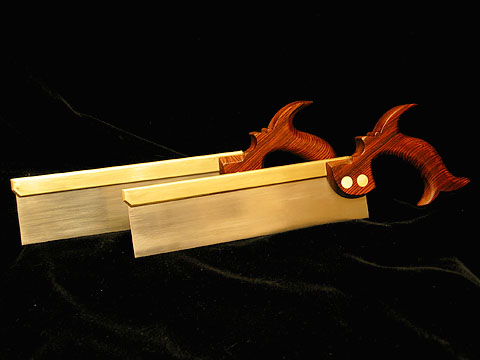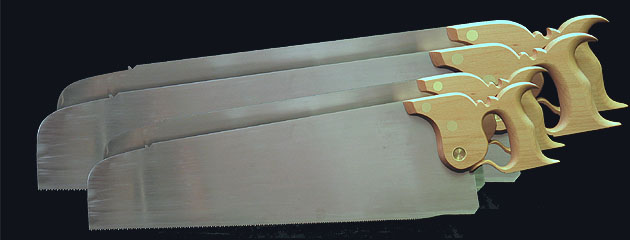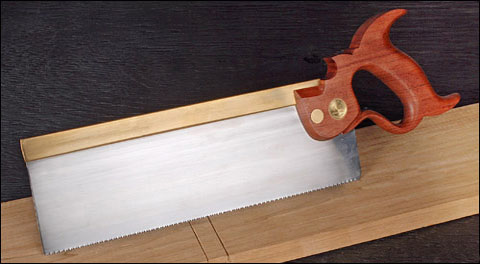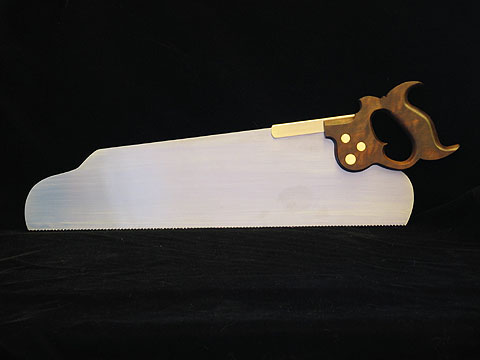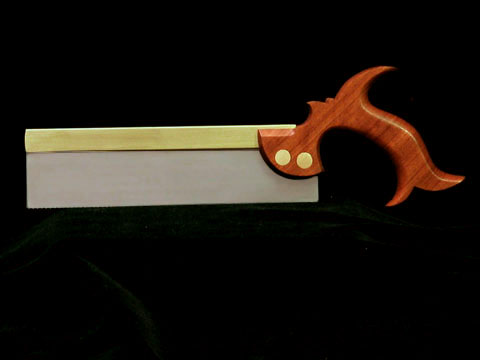
They may be a relatively small group, but the self-described “Neanderthal woodworkers,” folks who eschew power tools in favor of hand tools, are quite particular about what they use. Neanderthals insist that if you want the very best handsaws you should buy ones that are handmade. The cream of the crop of such saws, according to chat room literati, are those crafted by Mike Wenzloff. Along with two of his children, he operates Wenzloff and Sons, Saw Makers out of a relatively small Oregon workshop.
I found myself wondering not only what goes into making such fine quality tools by hand, but also why in this modern age these stalwart folks would choose such an unusual, almost anachronistic, endeavor. To learn more, I called and chatted with Mike himself, and asked him to tell me the story from the very beginning.
“In my junior year of high school,” Mike recounted, “my father and I started a shop repairing on-the-road big rigs. He had been a mechanic all his life. For me, it was an inducement to leave high school. We shared that business until late in 1977. By then my wife and I had bought 60 acres in the Idaho panhandle, up in the middle of nowhere. We built a log cabin with no electricity or running water, and I started a logging business.
“In 1988, I accidentally rolled a skidder down a hillside, which left me both injured and deeply in dept. We sold everything to get out of debt and moved back to Oregon, where I got my GED and went on to college. To pay for all that, I started a graphics design business doing technical illustration and writing.
“In 1998, I went to work for my best customer, again doing graphic design. That same year, I was diagnosed with cancer. After three and a half years, I went to work for a company doing data management service, designing and writing database codes used to publish catalogs. Up until 1998, I had spent most of my life working for myself and, frankly, found that working for someone else was not really a great fit. In 2005, I went back to working for myself.
“Throughout my life, my equivalent of a paper route was sharpening saws. It is something I have always done, along with making furniture, a craft I had learned from my grandfather, a Washington State prison guard, and my great-uncle, who was a logger. In 2005, I started building custom furniture full-time along with two of my now-adult sons. A health issue cropped up almost immediately which forced me to lay off my sons and shut down the shop.
“That same year, I was approached by a customer who had seen some of the saws I had made for myself, and he asked me to build a set of 20 saws for him. I made them, and continued to take in sharpening. By tax time, I realized I made more money making and sharpening saws than making furniture. Besides, I love making saws, so I kept the name Wenzloff and Sons and simply switched to making handmade saws.
“Just before Christmas of 2005, I announced to the online community that I was going to make my living making saws, and would go live on January first, 2006. Within a month, I was swamped with orders. I brought my sons back into the business, but even with all three of us, we soon had more than a 30-week waiting period. My nephew joined us recently, so there are now four of us. The three of us made and shipped about 30 saws per week; with the newest employee we should soon be able to do 50. Nevertheless, our current backlog is well over 3,000 saws.”
That’s certainly impressive, and it made me wonder just what about Wenzloff saws sets them apart from the competition. “We use thinner plate, lighter sets, and better sharpening,” Mike explained. “Mechanically, thinner, sharper blades with a lighter set give a smoother cut and require less effort. We also use significantly harder steel, which necessitates less frequent sharpening. Our ergonomic handles both fit the hand and look better. Overall, the saws have a better in-the-hand feel. To me, that means a combination of the handle hang, which is the angle between the handle and tooth line, and the handle comfort.
“Most of our handles are replicas of traditional shapes and sizes. Such handle sizes and shapes had been perfected from the mid-1700s on up until 1928. As machinery came in, some very comfortable handles, which were very difficult to make on shapers and routers, went away. The handle on our number nine saw is a good example. Complex curves went out, and single radius curves came in.
“We find that there is a broad range of people who will fit the average saw handle. However, we will make any saw with any handle. Most of our handles are done in bubinga and beech, but we also do rosewood, jatoba, imbuya, mesquite, African blackwood, ebony, figured walnut, figured maple, pink ivorywood or nearly any other wood that will make a decent handle.
“Hobby woodworkers make up some 80 percent of our business. They have more discretionary income, less brand loyalty and a greater appreciation of both quality and aesthetics. These same people prefer to be involved in the process of making their tools, which is why we, as a custom saw maker, appeal to them. Ironically, we use eight different vintage hand saws in the production of the saws we make.
“We also sharpen saws differently depending on whether you are cutting mostly softwoods as opposed to hardwoods. Softwood saws get a more aggressive rake. I always ask what woods my customers typically use. Oak and ash, the ring-porous woods, for example, are some of the worst case woods, and require a more relaxed rake than normal when sharpening.”
Still, Mike is quick to point out that not everyone needs what he makes. “There will always be functional tools that will work for 90 percent of the market,” he maintains, “and most don’t need a custom saw. If there is no compelling reason, don’t spend money on a custom saw. We routinely tell our customers that. If you already have a saw that will do what you need it to do, don’t replace it.”
For some, though, there are some very good reasons to buy these handcrafted gems. “Great saws appeal at a level different than mere functionality,” Mike points out. “If you want to have a hand in custom filing, custom wood and handle shape, and end up with a saw that works well and comfortably, you probably want a custom saw. The bottom line, though, is that the skill of the person using the saw is a lot more important than the saw.”
